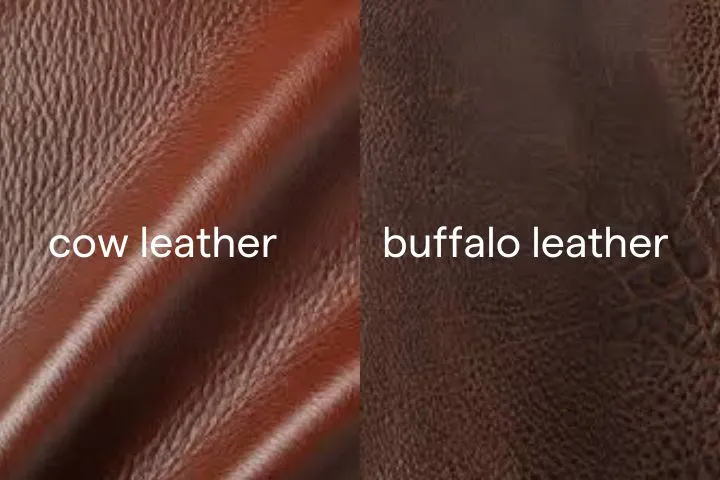Introduction
Vegan leather is everywhere. From the runways of high fashion to the interiors of electric cars, this animal-free alternative has exploded in popularity. A powerful combination of ethical concerns, environmental awareness, and material innovation drives this trend. As consumers in 2025 become more conscious of their purchasing decisions, the demand for cruelty-free products has skyrocketed. This has turned vegan leather into a major force in the global accessories market. But with this rise in popularity has come a wave of confusion. Is all vegan leather truly sustainable? Is it as durable as the real thing? The term itself covers a vast and rapidly evolving category of materials, from traditional plastics to groundbreaking fabrics made from pineapples and cacti.
Vegan leather is any material designed to mimic the look and feel of traditional animal leather without using any animal products. It falls into two main categories: synthetic leathers, which are plastic-based (like PU and PVC), and innovative plant-based leathers derived from sources like pineapples, cacti, or mushrooms. While celebrated for being cruelty-free, its environmental impact and durability vary widely depending on the specific material it is made from.
Navigating the world of vegan leather can be tricky. Misconceptions are common, and not all alternatives are created equal. Is a plastic-based faux leather really better for the planet than a responsibly sourced animal hide? This guide is here to provide the definitive answers. We will explore the different types of vegan leather, break down how they are made, and offer a clear-eyed analysis of their pros, cons, and true environmental impact. Get ready to discover the fascinating story behind the materials shaping the future of fashion.
What is Vegan Leather?
Vegan leather is a cruelty-free material that mimics real leather. It is made from either artificial or plant-based sources, not animal hides. The two main types are synthetic leathers like PU and PVC, and newer, more sustainable plant-based options made from materials like pineapples or cacti. While always animal-friendly, its environmental impact varies greatly depending on the type.
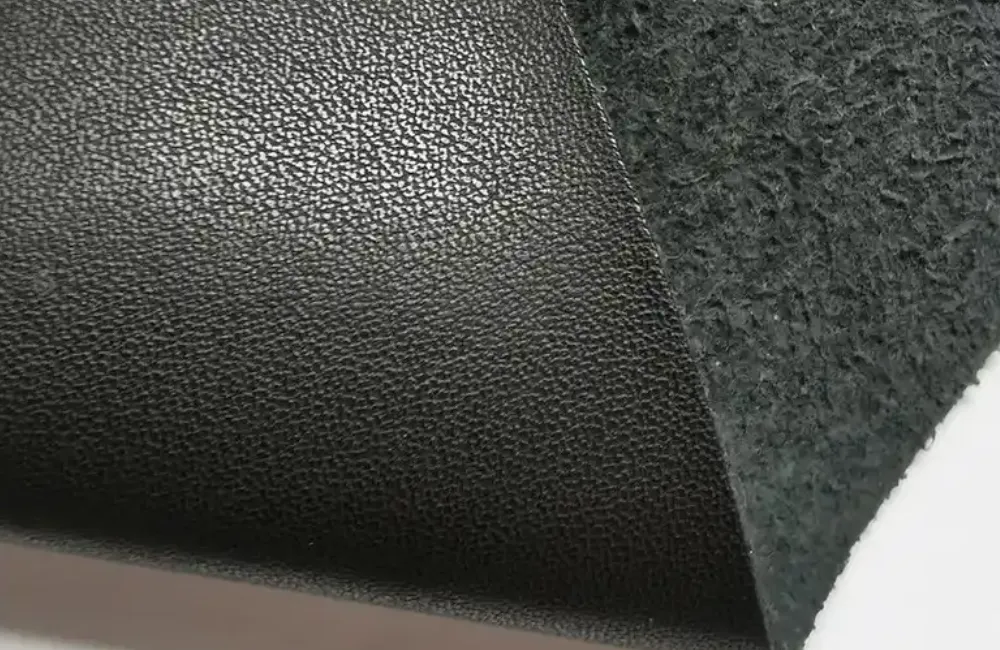
A Clear Definition
At its core, the definition is simple. Vegan leather is any material that looks and feels like leather but is made without using any animal products. It’s a broad term that covers a wide range of materials. You might also see it called “faux leather,” “artificial leather,” or “pleather.” While these terms all mean the same thing—no animals were harmed—the materials themselves can be dramatically different. They fall into two main camps:
- Synthetic Leathers: These are the most common types, made from plastics like Polyurethane (PU) or Polyvinyl Chloride (PVC).
- Plant-Based Leathers: These are newer, innovative materials made from natural sources like pineapple leaves, cactus, or mushrooms.
The History and Evolution of Vegan Leather
The idea of an animal-free leather alternative is not new. The first versions emerged in the early 20th century with the invention of plastics. PVC was one of the first materials used to create an artificial leather, often called “pleather.” It was cheap and waterproof, but it was also stiff, not breathable, and had a distinctly plastic feel. In the decades that followed, PU leather was developed. It offered a softer, more flexible, and more convincing alternative, and it quickly became the standard for affordable faux leather goods.
The 21st century, however, has brought a revolution in vegan materials. Driven by a growing demand for sustainability, innovators began to look beyond plastics. This has led to the exciting development of plant-based leathers. These new materials use natural, often recycled, waste products from agriculture to create fabrics that are not only cruelty-free but also have a much smaller environmental footprint than their plastic-based predecessors.
Addressing Common Misconceptions
The biggest misconception about vegan leather is that “vegan” automatically means “eco-friendly.” This is not always the case. While all vegan leather is cruelty-free, its environmental impact is a much more complicated story.
Traditional synthetic leathers like PVC are petroleum-based plastics. Their production can involve toxic chemicals and contribute to microplastic pollution. They are also not biodegradable. In contrast, new plant-based leathers are often made from sustainable resources and are designed to be biodegradable. Understanding this difference is key to making a truly conscious choice. The “vegan” label tells you about animal welfare, but it doesn’t tell you the whole story about sustainability.
Types of Vegan Leather
Vegan leather comes in two main categories. The first is synthetic leather, made from plastics like Polyurethane (PU) and Polyvinyl Chloride (PVC). The second, more modern category is plant-based leather, made from sustainable sources like pineapple leaves (Piñatex), cactus (Desserto), mushrooms, and cork. While synthetics are affordable, plant-based options offer a more eco-friendly and often higher-quality alternative.
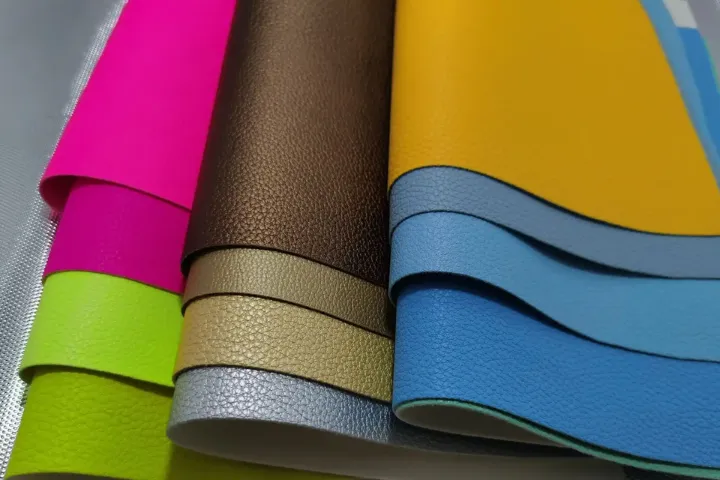
The term “vegan leather” is an umbrella that covers a diverse and growing family of materials. They range from mass-produced plastics to innovative, sustainable textiles. Understanding the key types is the first step to making an informed choice.
PU Leather (Polyurethane)
PU leather is the most common type of synthetic leather. Manufacturers create it by applying a liquid layer of polyurethane over a fabric base, like cotton or polyester. This process creates a material that is soft, flexible, and can be made in any color or finish. Its versatility and low cost make it a favorite for fast-fashion items like jackets, shoes, and handbags. However, it is not very breathable and, as a plastic, it is not biodegradable.
PVC Leather (Polyvinyl Chloride)
PVC is another common plastic-based leather. It is made by combining PVC with stabilizers and plasticizers, which are then coated onto a fabric base. PVC is very durable and easy to clean, which makes it a popular choice for furniture upholstery and car interiors. However, it has significant environmental drawbacks. The production of PVC releases toxic chemicals called dioxins, and it is not biodegradable, making it one of the least eco-friendly options.
Microfiber Leather
Microfiber leather is a high-end synthetic that offers a more convincing alternative to real leather. It is made from a blend of microfiber strands (typically polyester and nylon) that are intricately woven together to mimic the fibrous structure of a real hide. This makes it much more durable and breathable than standard PU or PVC leather. It is often used in premium automotive interiors and high-performance footwear.
Piñatex (Pineapple Leather)
Piñatex is a pioneer in the world of plant-based leather. It is a natural, sustainable material made from the waste fibers of pineapple leaves, a byproduct of the existing pineapple harvest in the Philippines.
The fibers are extracted, processed, and combined with a corn-based polylactic acid (PLA) to create a durable, non-woven textile. It has a unique, slightly wrinkled texture and is used by eco-conscious brands for bags, shoes, and accessories.
Cork Leather
Cork leather is another highly sustainable option. It is made by harvesting the outer bark of the cork oak tree, a process that does not harm the tree and can be repeated every nine years. The harvested cork is then boiled, dried, and sliced into thin sheets, which are laminated onto a fabric backing. The result is a material that is lightweight, waterproof, and has a beautiful, natural texture. It is a popular choice for wallets and small accessories.
Mushroom Leather (Mycelium-Based)
This is one of the most exciting innovations in sustainable materials. Mushroom leather is grown, not manufactured, from mycelium—the root structure of mushrooms. In a controlled environment, the mycelium can be grown into a sheet that has the look and feel of animal leather. It is a completely natural and biodegradable material that is being adopted by a growing number of luxury brands.
Other Plant-Based Options
The world of plant-based leather is expanding rapidly. Other innovative materials include:
- Desserto (Cactus Leather): A soft, durable material made from the leaves of the nopal cactus in Mexico.
- AppleSkin: Made from the waste pulp and peels from the apple juice industry in Italy.
- Bananatex: A tough, waterproof fabric made from the fibers of the banana plant.
Types of Vegan Leather: A Comparison
| Type | Source Material | Key Advantage | Key Disadvantage |
|---|---|---|---|
| PU Leather | Plastic (Polyurethane) | Affordable and Versatile | Not Breathable, Not Eco-Friendly |
| PVC Leather | Plastic (Polyvinyl Chloride) | Durable and Easy to Clean | Toxic Production, Not Eco-Friendly |
| Piñatex | Pineapple Leaf Fibers | Highly Sustainable, Uses Waste | Less Durable Than Synthetics |
| Cork Leather | Cork Oak Bark | Waterproof, Lightweight, Eco-Friendly | Distinct, Non-Traditional Look |
| Mushroom Leather | Mycelium (Mushroom Roots) | Biodegradable, Natural | Expensive and Still Scaling |
How is Vegan Leather Made?
Vegan leather is made in two main ways. Synthetic leathers are produced by coating a fabric base (like cotton or polyester) with a layer of plastic, either polyurethane (PU) or polyvinyl chloride (PVC). Plant-based leathers are made by harvesting natural materials like pineapple leaves or cork, processing them into a fibrous pulp, and then binding them together to create a durable, leather-like textile.
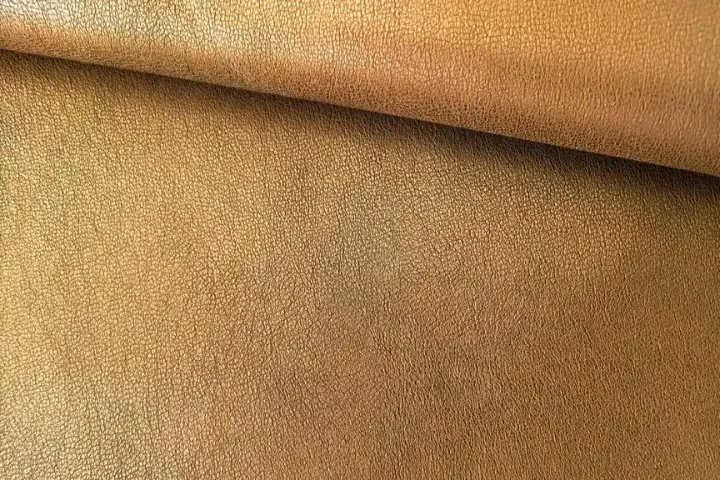
The manufacturing process for vegan leather varies dramatically depending on whether it is a traditional synthetic or a modern plant-based material. Understanding these two different paths is key to understanding their differences in quality and environmental impact.
Synthetic Production Process
The creation of plastic-based leathers like PU and PVC is a multi-step industrial process:
- Base Material Selection: The process starts with a fabric base, which provides structure. This is typically made from cotton or polyester.
- Coating and Laminating: A liquid layer of plastic—either polyurethane or polyvinyl chloride—is coated or laminated onto the fabric base. Multiple layers may be applied to achieve the desired thickness and durability.
- Embossing for Texture: While the plastic is still pliable, it is passed through heated rollers that are embossed with an artificial, leather-like grain pattern. This is what gives the final product its leather-like appearance.
Plant-Based Production Process
The process for creating plant-based leathers is more natural and often more complex, as it involves turning raw organic matter into a durable fabric.
Using Piñatex as an example, the process is a beautiful showcase of sustainable innovation. It takes a waste product from one industry and transforms it into a valuable raw material for another.
The typical steps include:
- Harvesting Raw Materials: The process begins with the collection of the natural source, such as pineapple leaves, cactus leaves, or apple peels.
- Processing into Fibers: The raw materials are then processed to extract their natural fibers. This often involves crushing, washing, and drying to create a fibrous pulp.
- Binding and Finishing: This pulp is then mixed with a bio-based binder (like corn-based PLA) and pressed into sheets. These sheets are then dried and finished, sometimes with a light coating, to create the final, durable textile.
As this field continues to innovate, scientists are developing new methods of bio-fabrication, such as growing mushroom leather in a lab, which further reduces the need for chemicals and resources.
Pros and Cons of Vegan Leather
Vegan leather’s main advantages are that it is cruelty-free, affordable, and available in many colors and textures. It is also generally water-resistant and easy to clean. However, its disadvantages include lower durability than real leather, a lack of breathability (especially in synthetics), and the significant environmental impact of plastic-based versions, which are not biodegradable.
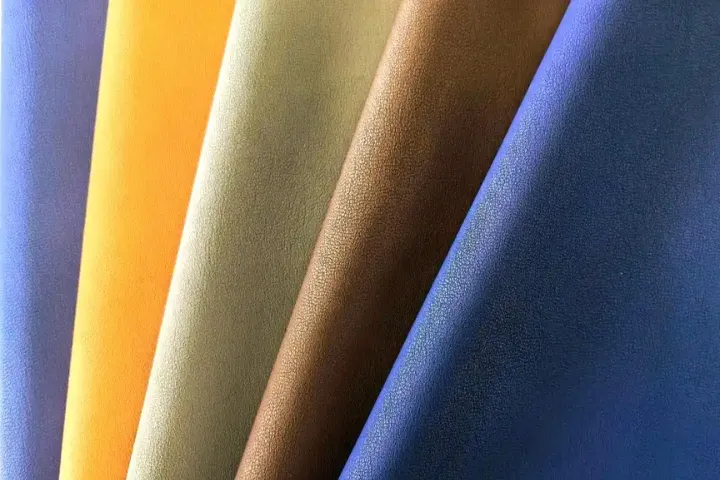
Advantages
The rise of vegan leather is driven by several powerful benefits that appeal to modern consumers and brands.
- Cruelty-Free and Ethical Appeal: This is the number one advantage. For those who object to the use of animal products, vegan leather offers a completely animal-friendly alternative.
- Affordability: Synthetic leathers like PU and PVC are significantly cheaper to produce than real leather, making them an excellent choice for budget-friendly fashion and accessories.
- Variety and Versatility: Because it is an artificial material, synthetic leather can be produced in virtually any color, texture, or finish imaginable, offering endless design possibilities.
- Water Resistance: Plastic-based leathers are essentially waterproof, making them very easy to clean with a simple wipe-down and suitable for items that will be exposed to the elements.
Disadvantages
However, the benefits of vegan leather, particularly the synthetic types, come with some significant trade-offs.
- Lower Durability: Most synthetic leathers are not as strong or long-lasting as real leather. They are prone to cracking, peeling, and tearing over time and will not develop a beautiful patina.
- Environmental Concerns with Synthetics: PU and PVC are plastics derived from fossil fuels. Their production can be energy-intensive, and they are not biodegradable, contributing to plastic pollution at the end of their shorter lifespan.
- Lack of Breathability: Unlike real leather, which is a natural, porous skin, plastic-based leathers do not breathe. This can make them feel hot and sticky when used for clothing or shoes.
The choice to use vegan leather often comes down to a complex ethical calculation. While it is always cruelty-free, the environmental cost of a short-lived plastic product can sometimes be higher than that of a long-lasting, natural, and biodegradable animal hide.
Environmental Impact of Vegan Leather
The environmental impact of vegan leather is complex. While it avoids the ethical issues of animal agriculture, synthetic versions like PVC and PU are derived from fossil fuels, are not biodegradable, and can release microplastics. In contrast, newer plant-based leathers are far more sustainable, using agricultural waste and often being biodegradable. Therefore, the eco-friendliness of vegan leather depends entirely on the material.
Positive Aspects
The primary environmental argument for vegan leather is rooted in its avoidance of industrial animal agriculture, which is a major contributor to deforestation and greenhouse gas emissions. Key positive aspects include:
- No Animal Exploitation: This is the core ethical and environmental benefit.
- Use of Agricultural Waste: Innovative plant-based options like Piñatex and AppleSkin turn waste from other industries into a valuable resource, promoting a circular economy.
- Lower Water Usage (in some cases): The production of some plant-based leathers, like cactus leather, requires significantly less water than the process of raising cattle and tanning their hides.
Negative Aspects
The “vegan” label can often hide significant environmental downsides, particularly with traditional synthetic leathers.
- Fossil Fuel Dependency: PU and PVC are plastics, which means they are derived from petroleum, a non-renewable resource.
- Microplastic Pollution: As synthetic leather products wear down, they shed tiny plastic particles that pollute our waterways and ecosystems.
- Shorter Lifespan: Because they are less durable than real leather, synthetic products need to be replaced more often, contributing to a cycle of consumption and waste.
Comparison with Real Leather
Life Cycle Assessments (LCAs) that compare different materials often show a complex picture. While real leather has a high impact during the farming and tanning stages, its incredible longevity means a single product can last for decades. A synthetic vegan leather product, in contrast, has a lower initial impact but a much shorter lifespan, meaning several of them might be needed to last as long as one real leather item.
Ultimately, the most sustainable choice is not simply “vegan vs. real.” It’s about choosing a durable, long-lasting product, whether that’s a responsibly sourced, vegetable-tanned leather or a high-quality, innovative plant-based alternative. For brands, seeking out suppliers with certifications like the Global Recycled Standard (GRS) or working with manufacturers like Hoplok Leather who are transparent about their material sourcing is the best way to make a truly sustainable choice.
Durability, Maintenance, and Care for Vegan Leather
The durability of vegan leather varies. High-quality synthetics and plant-based options can be quite durable, but most are less long-lasting than real leather and can be prone to cracking. Care is generally simple: a wipe-down with a damp cloth is usually sufficient. However, repairing tears or scratches on synthetic leather is very difficult, making proper care essential to extend its lifespan.
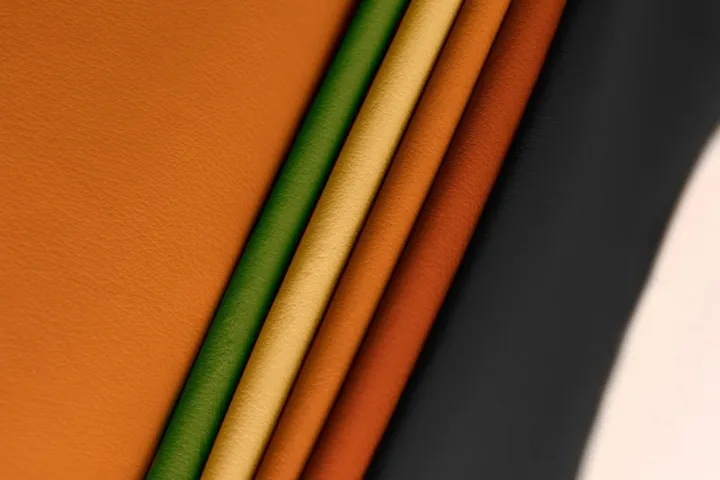
How Durable is Vegan Leather?
The longevity of vegan leather depends entirely on its type and quality. High-end microfiber leather, for example, can be very durable. Most standard PU leathers, however, are significantly less durable than real leather. They are prone to cracking, peeling, and tearing after only a few years of regular use. Plant-based leathers are a promising alternative, with materials like cactus leather showing excellent resistance to tearing, but their long-term durability is still being tested in the market.
Cleaning and Maintenance Tips
One of the great advantages of vegan leather is that it is generally very easy to clean. For most synthetic and plant-based leathers, you can follow these simple steps:
- Wipe It Down: Use a soft cloth dampened with a bit of warm water and a mild soap to gently wipe the surface.
- Dry It Off: Use a clean, dry cloth to wipe away any moisture.
- Avoid Harsh Chemicals: Never use harsh cleaners, solvents, or abrasive pads, as they can damage the plastic coating.
Repairing and Customizing Vegan Leather
Repairing synthetic leather is notoriously difficult. Unlike real leather, which can be conditioned and polished to hide scuffs, a tear or a peel on a PU or PVC surface is often permanent.
For small tears, a vinyl repair kit can sometimes work, but it is difficult to achieve a seamless result. It is also not possible to soften or distress most synthetic leathers in the same way as real leather. The best approach is to focus on preventative care to extend the product’s life as much as possible.
Vegan Leather vs. Real Leather: A Detailed Comparison
The choice between vegan and real leather involves trade-offs. Vegan leather is cruelty-free, affordable, and easy to clean, but often less durable and breathable. Real leather is exceptionally durable and develops a beautiful patina but has a higher cost and ethical concerns. Plant-based vegan leathers are closing the gap, offering a more sustainable and durable alternative to traditional synthetics.
Appearance, Feel, and Smell
Your senses are the quickest way to tell the difference. Real leather has a rich, earthy smell and a unique, imperfect grain pattern. It feels warm and supple to the touch. In contrast, synthetic vegan leather often has a chemical or plastic smell and a perfectly uniform, repeating texture that can feel cold and artificial. High-quality plant-based leathers, however, are getting much closer to mimicking the natural feel of real leather.
Cost, Ethics, and Environmental Footprint
This is where the decision becomes complex.
- Cost: Synthetic vegan leather is almost always cheaper than real leather. Plant-based leathers are often priced similarly to mid-tier real leather.
- Ethics: Vegan leather is the clear winner on cruelty-free grounds.
- Environment: The debate is ongoing. Real leather has a high impact from animal agriculture but is a long-lasting, biodegradable byproduct. Plastic-based vegan leather avoids this but has issues with fossil fuels and microplastic pollution. Sustainable, plant-based leathers are emerging as the best option from an environmental perspective.
Performance and Durability
When it comes to performance, high-quality real leather is still the champion. Its tensile strength and breathability are hard to beat. A full-grain leather product can last for decades, while a synthetic vegan leather product may only last a few years.
However, high-end synthetics like microfiber leather are closing the gap in durability, and plant-based options are proving to be surprisingly resilient. For pure waterproof performance, synthetics have the edge.
When to Choose One Over the Other
Choose real leather for investment pieces where longevity and a beautiful patina are your top priorities, such as a classic handbag or a durable pair of boots. Choose vegan leather for trendy, affordable fashion items, for products where you need guaranteed water resistance, or, most importantly, if your primary concern is animal welfare. For a balance of ethics and sustainability, a high-quality plant-based leather is the ideal modern choice.
The Future of Vegan Leather: Trends and Innovations
The future of vegan leather is focused on sustainability and performance. Key trends include the rise of lab-grown bio-leathers and advanced materials made from recycled plastics. The market is projected to grow significantly as major brands and celebrity endorsements push these eco-friendly alternatives into the mainstream. The main challenge will be scaling these new technologies to be cost-competitive with traditional materials.
Emerging Technologies
The most exciting frontier in vegan leather is bio-fabrication. Scientists are now able to grow leather-like materials in a lab using mycelium (the root structure of mushrooms) or by cultivating collagen, the protein that makes up animal hides. These technologies promise a future where we can have materials with the exact properties of leather, without the need for animals or petroleum. Additionally, innovations in recycling are allowing brands to create high-quality vegan leather from post-consumer plastics, helping to address the global plastic waste problem.
Market Growth and Brand Shifts
The vegan leather market is predicted to grow at a rapid pace, with some estimates projecting a CAGR of nearly 10% through 2025. This growth is driven by major fashion brands, from Stella McCartney to Adidas, who are increasingly incorporating sustainable, vegan materials into their collections. Celebrity endorsements and a growing consumer demand for ethical products are accelerating this shift, making vegan leather a major force in the future of fashion.
Potential Challenges and Opportunities
The biggest challenge for the next generation of vegan leathers is scale. While materials like mushroom and cactus leather are incredibly promising, the ability to produce them at a scale and cost that can compete with traditional leather and synthetics is still a major hurdle.
However, this challenge also presents a huge opportunity. The brands and manufacturers who can successfully scale these new, sustainable technologies will be the leaders of the future, meeting the demands of a new generation of conscious consumers.
Frequently Asked Questions (FAQs)
Common questions about vegan leather focus on its durability and environmental impact. The lifespan of vegan leather varies, with synthetics lasting a few years and plant-based options being more durable. Most synthetic leathers are waterproof. The main disadvantage is the environmental footprint of plastic-based versions. Whether it is better for the environment than real leather is a complex debate that depends on the specific material and its lifespan.
Is vegan leather biodegradable?
It depends. Plastic-based leathers like PU and PVC are not biodegradable. However, many new plant-based leathers, such as those made from mushrooms or cork, are designed to be fully biodegradable.
How long does vegan leather last?
The lifespan varies greatly. A cheap PU leather product might only last a year or two before peeling. A high-quality microfiber or plant-based leather product can last for five years or more, though this is still generally less than high-quality real leather.
Is vegan leather waterproof?
Synthetic leathers like PU and PVC are waterproof due to their plastic coating. The water resistance of plant-based leathers varies by material, but most are at least water-resistant.
What are the disadvantages of vegan leather?
The main disadvantages are lower durability compared to real leather, a lack of breathability in synthetic versions, and the negative environmental impact of petroleum-based plastics.
Is vegan leather better than real leather for the environment?
This is a complex question with no easy answer. Plant-based vegan leathers are likely better. However, a long-lasting real leather product can be more sustainable than a short-lived, disposable plastic one.
Can you tell the difference between vegan and real leather?
Yes. You can usually tell by the smell (real leather has an earthy scent, fakes smell like plastic), the feel (fakes are often cold and unnaturally smooth), and by looking at the raw edges (real leather is fibrous, fakes are smooth).
Conclusion
Vegan leather is more than just a single material; it’s a diverse and rapidly evolving category that represents the future of conscious fashion. From affordable synthetics to groundbreaking plant-based innovations, it offers a cruelty-free alternative for every consumer and every application. The key is to be an informed buyer. Understanding the difference between a petroleum-based plastic and a sustainable, biodegradable textile is crucial for making a choice that aligns with your values.
As we look to 2025 and beyond, the trend is clear: the demand for high-quality, sustainable, and ethically produced materials will only continue to grow. The future of the industry lies in the incredible innovations of plant-based leathers. At Hoplok Leather, we are committed to being at the forefront of this movement. We have the expertise to work with a wide range of materials, both traditional and innovative, and we can help your brand navigate this exciting new landscape. Whether you are looking to create a collection from the finest Italian cowhide or the latest sustainable vegan alternative, our 22 years of experience can help you bring your vision to life.
Ready to Explore the Future of Leather?
Whether you’re interested in traditional leathers or the latest in sustainable vegan alternatives, we have the expertise to guide you. At Hoplok Leather, we specialize in sourcing and manufacturing a wide range of high-quality materials to meet the unique needs of your brand. Let us help you create a product line that is beautiful, durable, and conscious.



